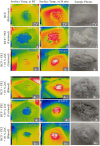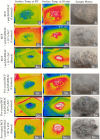Enhanced Photothermal Based-Heat Retention in Regenerated Cellulose Fibers via Ceramic Particles and Polyelectrolyte Binders-Based Surface Functionalization
- PMID: 40219350
- PMCID: PMC11991084
- DOI: 10.3390/polym17070961
Enhanced Photothermal Based-Heat Retention in Regenerated Cellulose Fibers via Ceramic Particles and Polyelectrolyte Binders-Based Surface Functionalization
Abstract
There has been growing interest and increasing attention in the field of functional clothing textiles, particularly in product and process development, as well as innovations in heat-generating, retaining, and releasing fibers to maintain a healthy body temperature without relying on unsustainable energy sources. This study, for the first time, reports the various physio-mechanical properties of surface-functionalized regenerated cellulose fibers (RCFs) coated with ceramic particles. The coating imparts photothermal conversion-based heat generation and retention properties with the aid of polyelectrolyte binders. In this design, ZrC enables the conversion of light energy into thermal energy, providing heat for the human body. A feasible coating process was employed, utilizing industrially feasible exhaustion methods to deposit the ZrC particles onto the RCF surface in conjunction with two distinctive polymeric binders, specifically polyethyleneimine (PEI) and polydiallyldimethylammonium chloride (polyDADMAC). The morphological characteristics and tensile properties of the coated RCFs were analyzed via scanning electron microscopy (SEM) and single-fiber tensile testing. Heat retention and release behaviors of a bundle of fiber samples were assessed using infrared (IR) imaging and an IR emission lamp setup. The SEM results confirmed the successful coating of the ZrC particles on the surface of the RCF samples, influencing negligible on their physical-mechanical properties. The heat retention of the coated RCFs with ZrC and both binders was higher than that of reference regenerated cellulose fibers (RCFs), demonstrating their effective heat generation, retention, and heat release properties. Based on the highlighted prominent results for the coated RCFs, these findings highlight the suitability of the developed functional clothing textiles for targeted applications in non-extreme thermal conditions, ensuring thermo-physiological comfort by maintaining body temperature within a tolerable thermal range (36.5-37.5 °C), in contrast to studies reporting significantly higher temperatures (50-78 °C) for extreme thermal conditions.
Keywords: RCFs; ZrC; ceramic particles; heat generation and retention; regenerated cellulose fibers; surface functionalization; zirconium carbide.
Conflict of interest statement
Co-author, Dr. Ajra Hadela, from Institute for Environmental Protection and Sensors (IOS) Ltd., Slovenia, declares no conflict of interest. Corresponding author, Mr. Özkan Yapar, and co-author, Prof. Dr. Aleksandra Lobnik, from the Faculty of Mechanical Engineering, University of Maribor, Slovenia, and the Institute for Environmental Protection and Sensors (IOS) Ltd., Slovenia, declare no conflict of interest. Co-author, Assoc. Prof. Dr. Alenka Ojstršek, from the Faculty of Mechanical Engineering, University of Maribor, Slovenia, declares no conflict of interest.
Figures









Similar articles
-
High-Efficiency Electro/Solar-Driven Wearable Heater Tailored by Superelastic Hollow-Porous Polypyrrole/Polyurethane/Zirconium Carbide Fibers for Personal Cold Protection.ACS Appl Mater Interfaces. 2022 Jun 1;14(21):24820-24831. doi: 10.1021/acsami.2c05155. Epub 2022 May 23. ACS Appl Mater Interfaces. 2022. PMID: 35603561
-
Microstructures of a SiC-ZrC Ceramic Fiber Derived from a Polymeric Precursor.Materials (Basel). 2020 May 6;13(9):2142. doi: 10.3390/ma13092142. Materials (Basel). 2020. PMID: 32384643 Free PMC article.
-
Carbon Nanofiber Arrays Grown on Three-Dimensional Carbon Fiber Architecture Substrate and Enhanced Interface Performance of Carbon Fiber and Zirconium Carbide Coating.ACS Appl Mater Interfaces. 2017 May 24;9(20):17337-17346. doi: 10.1021/acsami.7b02503. Epub 2017 May 12. ACS Appl Mater Interfaces. 2017. PMID: 28485921
-
Ceramic Composite Materials Obtained by Electron-Beam Physical Vapor Deposition Used as Thermal Barriers in the Aerospace Industry.Nanomaterials (Basel). 2020 Feb 20;10(2):370. doi: 10.3390/nano10020370. Nanomaterials (Basel). 2020. PMID: 32093247 Free PMC article. Review.
-
Zirconium Carbide for Hypersonic Applications, Opportunities and Challenges.Materials (Basel). 2023 Sep 11;16(18):6158. doi: 10.3390/ma16186158. Materials (Basel). 2023. PMID: 37763436 Free PMC article. Review.
References
-
- Pan N., Sun G. Functional Textiles for Improved Performance, Protection and Health. Woodhead Publishing; Oxford, UK: 2011. (Woodhead publishing series in textiles).
-
- Xu J., Jiang S., Wang Y., Shang S., Miao D., Guo R. Photo-thermal conversion and thermal insulation properties of ZrC coated polyester fabric. Fibers Polym. 2017;18:1938–1944. doi: 10.1007/s12221-017-1237-z. - DOI
Grants and funding
- 764713/the European Union's Horizon 2020 research and innovation programme under the Marie Sklodowska-Curie
- research project (No. Z2-4483) and research programmes (No. P2-0424 and P2-0438)/the Slovenian Research and Innovation Agency (ARIS)
- 190115848-OpenLOOP-HORIZON-EIC-2022-ACCELERATOR-01/EU project OpenLOOP
- (Contract No. C3330-19-952032)/Ministry of Education, Science and Sport of the Republic of Slovenia, the European Union, the European Regional Development Fund (ERDF), and Early Research Career 2.1
- (No. P2-0424)/Slovenian Research and Innovation Agency (ARIS)
LinkOut - more resources
Full Text Sources

